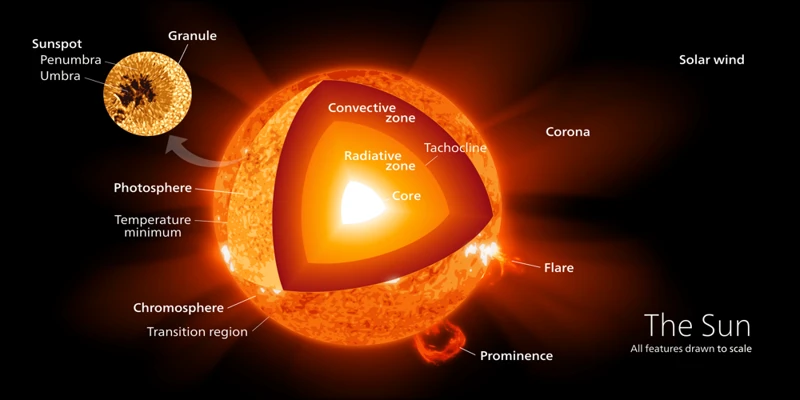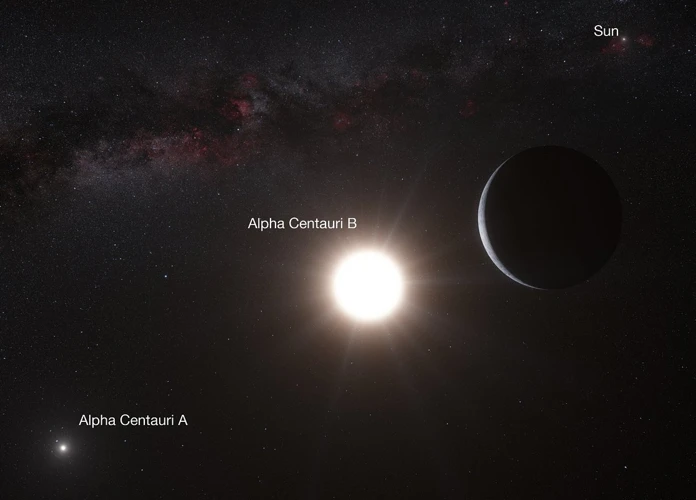The glowing celestial orb that graces our daytime sky has always captivated humanity’s imagination. Its brilliant rays provide life-giving warmth and sustenance to our planet, serving as the ultimate source of energy. Every dawn serves as a reminder of our close stellar neighbor, the Sun. From ancient myths and cultural beliefs to scientific marvels and astrological interpretations, the Sun has shaped human understanding in countless ways. Join us as we explore the marvels of this cosmic entity, uncover its structure and composition, delve into solar activity, and discover the Sun’s profound impact on life on Earth. Get ready to embark on an enlightening journey through the celestial wonders of our closest star.
Contents
- The Sun: A Stellar Neighbor
- The Importance of the Sun
- The Sun’s Structure and Composition
- Solar Activity: Sunspots and Solar Flares
- Solar Eclipses: A Unique Cosmic Phenomenon
- The Role of the Sun in Astrology
- Conclusion
-
Frequently Asked Questions
- 1. How far is the Sun from Earth?
- 2. What is the temperature of the Sun’s core?
- 3. How does the Sun produce energy?
- 4. Can humans ever visit the Sun?
- 5. How long does it take for sunlight to reach Earth?
- 6. What is the Sun made of?
- 7. Can you look directly at the Sun?
- 8. How long will the Sun continue to shine?
- 9. What are sunspots?
- 10. Can the Sun ever go out?
- References
-
Frequently Asked Questions
- 1. How far is the Sun from Earth?
- 2. What is the temperature of the Sun?
- 3. How does the Sun produce energy?
- 4. How long does it take for sunlight to reach Earth?
- 5. Why is the Sun considered a star?
- 6. Can we look directly at the Sun?
- 7. Can the Sun ever burn out?
- 8. How do sunspots form on the Sun’s surface?
- 9. Can solar flares affect Earth?
- 10. What is the corona of the Sun?
- References
- Read More
The Sun: A Stellar Neighbor

Our solar system is part of a vast cosmic neighborhood, with the Sun taking center stage as our closest stellar neighbor. Located approximately 93 million miles away from Earth, the Sun is a yellow dwarf star belonging to the main sequence of stars. Compared to other stars in the universe, the Sun is considered fairly average in terms of size, luminosity, and temperature. However, its proximity to Earth makes it a crucial component of our existence and a subject of endless fascination. As we explore the wonders of the Sun, we will uncover its significance in sustaining life on Earth, its role in providing energy and heat, and its influence on weather and climate patterns. The Sun’s proximity to Earth also presents unique opportunities to study solar activity, such as sunspots and solar flares, which impact our planet in various ways. So, let’s embark on a journey to unravel the mysteries of our stellar neighbor and gain a deeper appreciation for the magnificent celestial body that graces our skies every day.
The Importance of the Sun

The Sun’s importance to life on Earth cannot be overstated. Its role extends far beyond being a radiant ball of light in the sky. Here are three key reasons why the Sun is essential for our existence:
- Sustaining Life on Earth: The Sun’s energy facilitates photosynthesis, the process by which plants convert sunlight into nourishment. This, in turn, serves as the foundation of the food chain, supporting all life forms on our planet. Without the Sun’s energy, life as we know it would cease to exist.
- Providing Energy and Heat: The Sun’s immense energy output is harnessed by humans through solar power. Solar panels convert sunlight into electricity, offering a clean and renewable energy source. Additionally, the Sun’s heat plays a crucial role in regulating Earth’s temperature and enables the water cycle, essential for weather patterns and the overall climate system.
- Driving Weather and Climate: Solar radiation heats the Earth unevenly, which in turn generates winds and ocean currents. These atmospheric and oceanic movements directly impact weather patterns, creating diverse climates around the globe. The Sun’s influence on weather and climate also affects agricultural productivity, water availability, and overall ecosystem stability.
These are just a few examples of the Sun’s immense significance. By understanding the role of our closest star, we can better appreciate the intricate interplay between the cosmos and our planet. The Sun’s position as the cornerstone of our existence reminds us of the intricacies of the universe and our place within it.
1. Sustaining Life on Earth
The role of the Sun in sustaining life on Earth cannot be overstated. Without the Sun’s warmth and light, life as we know it would cease to exist. The Sun’s radiant energy provides the driving force for photosynthesis, the process by which plants convert carbon dioxide and water into oxygen and glucose. This oxygen is then released into the atmosphere, creating the essential element for respiration in all living organisms. Additionally, the Sun’s light is responsible for regulating our sleep-wake cycles, known as circadian rhythms, which play a vital role in maintaining our health and well-being. The Sun’s energy also powers the Earth’s climate systems, driving the circulation of air and ocean currents, which in turn affect the distribution of heat and moisture across the planet. Without the Sun’s steady energy input, our planet would be inhospitably cold and lifeless. So, it is clear that the Sun’s presence is not only appreciated for its beauty but also for its indispensable role in sustaining the delicate balance of life on Earth.
2. Providing Energy and Heat
One of the most vital roles of the Sun is the provision of energy and heat to Earth. Through a process called nuclear fusion, the Sun converts hydrogen atoms into helium, releasing an enormous amount of energy in the process. This energy is emitted in the form of electromagnetic radiation, primarily in the form of visible light and heat. The Sun’s radiation is responsible for the warmth we feel on our skin and the light that illuminates our surroundings during the day. This energy is not only essential for the survival of plants and animals but also for the functioning of various systems on Earth. It drives the water cycle, powering evaporation and precipitation, which in turn sustains our freshwater supplies and agricultural practices. The Sun’s energy is also harnessed by humans through solar panels to generate electricity in a sustainable and environmentally friendly manner. Renewable energy sources like solar power have gained increasing significance in mitigating the carbon footprint of traditional fossil fuel-based energy systems. The Sun’s ability to provide us with an abundance of energy and heat is truly remarkable, making it a cornerstone of life on our planet.
3. Driving Weather and Climate
The Sun plays a significant role in driving weather and climate patterns on Earth. Its energy fuels the atmospheric processes that generate weather phenomena, such as wind, clouds, and precipitation. The uneven heating of the Earth’s surface by the Sun’s rays creates temperature gradients, which in turn create atmospheric pressure differences. These pressure differences drive the movement of air masses, resulting in wind patterns that circulate heat and moisture around the globe.
Additionally, the Sun’s energy drives the water cycle, the process by which water continually moves between the Earth’s surface and the atmosphere through evaporation, condensation, and precipitation. Evaporation occurs when the Sun’s heat causes water on the Earth’s surface, such as oceans, lakes, and rivers, to turn into vapor and rise into the atmosphere. As the vapor cools and condenses, it forms clouds, and when the conditions are right, precipitation occurs in the form of rain, snow, or hail.
The Sun also influences the formation and movement of weather systems, such as high and low-pressure systems, hurricanes, and tornadoes. The differential heating of the Earth’s surface by the Sun’s rays creates variations in temperature and air pressure, which drive the formation and movement of these weather systems. For example, the intense heating of tropical waters by the Sun provides the energy needed for the formation and intensification of tropical cyclones, known as hurricanes or typhoons.
The Sun’s energy is a crucial factor in determining the Earth’s overall climate. It plays a significant role in establishing the planet’s temperature, which in turn influences weather patterns on a long-term scale. Changes in the Sun’s energy output can impact global climate patterns, such as periods of warming or cooling. Scientists actively study the relationship between solar activity and climate change to gain a better understanding of these complex processes.
The Sun’s energy is responsible for driving weather and climate patterns on Earth. Its heat and light fuel the processes that generate wind, clouds, and precipitation, as well as influencing the temperature and overall climate of the planet. Understanding the Sun’s role in weather and climate is crucial for predicting and mitigating the impacts of natural disasters and for unraveling the complexities of our ever-changing climate.
The Sun’s Structure and Composition

The Sun’s structure and composition hold the secrets to its immense power and radiance. At its core, the Sun is a blistering-hot region with temperatures surpassing 15 million degrees Celsius. This is where nuclear fusion reactions occur, converting hydrogen into helium and releasing a tremendous amount of energy in the process. Surrounding the core is the radiative zone, where energy is transported through the slow and gradual movement of photons. Further outward is the convective zone, characterized by churning plasma currents that carry heat towards the Sun’s surface. The surface, known as the photosphere, is the region from where sunlight is emitted, appearing as a brilliant disk when observed from Earth. Above the photosphere lies the chromosphere, a layer of ionized gases that gives rise to the Sun’s reddish glow during solar eclipses. Finally, the outermost layer is the corona, an ethereal halo of extremely hot plasma extending millions of kilometers into space. Understanding the Sun’s structure and composition enables scientists to study its behavior, predict solar flares, and explore the fascinating phenomenon of the solar wind. The intricacies of the Sun’s structure open a universe of scientific discoveries and shed light on the workings of the greater cosmos.
1. Core
The core of the Sun is the central region where immense energy is generated through the process of nuclear fusion. This is the heart of our stellar neighbor, where temperatures and pressures reach staggering levels. The core of the Sun is primarily composed of hydrogen atoms that undergo fusion, converting into helium. Through this process, an enormous amount of energy is released in the form of light and heat. The core of the Sun is incredibly dense, with pressures exceeding billions of times the pressure found on Earth’s surface. The temperatures at the core can reach up to 15 million degrees Celsius, creating an environment where atoms collide with tremendous force and release energy. This process, known as thermonuclear fusion, is responsible for the Sun’s radiant glow and the continuous output of energy that sustains life on our planet. The core is surrounded by other layers and zones within the Sun, each playing a unique role in its structure and composition. To learn more about these intriguing layers, continue reading about the unraveling mysteries of black holes.
2. Radiative Zone
The Radiative Zone is a crucial region within the Sun’s structure, situated between the Core and the Convective Zone. It extends from the innermost regions of the Sun to about 70% of its radius. In this zone, energy generated in the Core begins its arduous journey towards the surface of the Sun. The primary mode of energy transport in the Radiative Zone is through radiation, hence its name. Photons, particles of light, are constantly emitted and absorbed by the plasma in this region as they make their way outwards. Due to the extremely high density of particles in the Radiative Zone, photons can take several thousands of years to traverse this region in a process known as random walk. This slow and intricate process arises from the dense plasma scattering and absorbing the photons repeatedly before they can escape. As a result, the Radiative Zone acts as a sort of cosmic obstacle course for photons, gradually releasing the energy generated in the Core. This energy transfer ensures that the Sun remains a stable and self-regulating celestial furnace, emitting the vital heat and light necessary for life on Earth. To fully understand the complexity of the Sun’s internal structure, we must examine the next zone in our journey, the Convective Zone.
3. Convective Zone
The convective zone is a crucial layer within the Sun’s structure, lying just above the radiative zone. This region is characterized by a transfer of energy through convection, where hot plasma rises to the surface, cools and sinks back towards the interior. Within the convective zone, vast columns of hot plasma known as convection cells churn and circulate, creating a bubbling, dynamic environment. These convection cells play a critical role in transferring energy from the core to the outer layers of the Sun. The convective zone is also responsible for generating the Sun’s magnetic field, which drives various solar phenomena such as sunspots and solar flares. Understanding the convective zone is essential in comprehending the inner workings of our closest star and the complex processes that shape its behavior. It provides significant insights into the mechanisms that govern the Sun’s energy production, magnetic activity, and overall dynamics. To delve deeper into the mysteries of the Sun’s convective zone, a thorough exploration of its relationship to other layers of the Sun’s structure is essential.
4. Photosphere
The photosphere is the visible surface of the Sun, the layer that emits the light that reaches Earth. This outer layer of the Sun’s atmosphere is composed primarily of hydrogen gas, with traces of other elements such as helium and small amounts of heavier elements. The photosphere has a temperature of around 5,500 degrees Celsius (9,932 degrees Fahrenheit) and appears as a bright, yellow disc when viewed from Earth. It is the layer where most of the Sun’s radiant energy is emitted as visible light. Sunspots, which are cooler, darker regions on the surface, are also visible in the photosphere. These sunspots are caused by magnetic activity within the Sun and can vary in size and intensity. Through telescopic observations, scientists can study the photosphere’s features and gain insights into the Sun’s magnetic field and its influence on solar activity. The photosphere serves as our window into the dynamic and ever-changing nature of our closest star, providing invaluable information for understanding the Sun’s behavior and its impact on Earth.
5. Chromosphere
The chromosphere is the layer of the Sun’s atmosphere located above the photosphere. It extends for about 2,000 kilometers and is characterized by a reddish glow, which gives it its name. This region is relatively thin compared to other layers of the Sun, but it plays a crucial role in the overall dynamics of solar activity. The temperature in the chromosphere increases as you move away from the photosphere, with temperatures reaching up to 20,000 Kelvin. The chromosphere is notable for its prominent features, such as spicules and prominences. Spicules are dynamic jets of gas that shoot upwards from the surface, while prominences are towering loops of plasma that arch over the Sun’s surface. These features can be observed during a solar eclipse when the Moon blocks out the bright light of the photosphere, allowing the chromosphere’s vibrant hues to become visible. The chromosphere also plays a role in the emission of ultraviolet light, which is responsible for the Sun’s ultraviolet spectrum. Studying the chromosphere allows scientists to gain a deeper understanding of solar dynamics and explore the impact of solar activity on our planet. So, while often overlooked in favor of the more famous layers of the Sun, the chromosphere holds significant scientific importance, enabling us to unravel the mysteries of our nearest star and its influence on our lives.
6. Corona
The outermost layer of the Sun’s atmosphere is known as the corona. This ethereal region extends millions of kilometers into space, appearing as a shimmering aura during a total solar eclipse. The corona is a region of extreme temperatures, reaching several million degrees Celsius, even hotter than the Sun’s surface. Its searing heat is the result of complex interactions between electrically charged particles and magnetic fields. Despite its high temperature, the corona’s density is incredibly low, making it difficult to detect without specialized instruments. It is composed mainly of ionized gases, such as hydrogen and helium, which create beautiful, wispy structures and streamers that can be observed during a solar eclipse. The corona is also responsible for the emission of solar winds, which are streams of energetic particles that continuously flow outward from the Sun. These solar winds can have an impact on Earth’s magnetosphere, causing phenomena such as the auroras. Exploring the corona and understanding its behavior is essential for studying the Sun’s influence on our planet and unraveling the mysteries of our vast cosmic neighborhood.
Solar Activity: Sunspots and Solar Flares

Solar activity, specifically sunspots and solar flares, is a mesmerizing phenomenon that occurs on the surface of the Sun. Sunspots are dark, cooler regions on the Sun’s photosphere that appear as dark spots when viewed from Earth. These areas are regions of intense magnetic activity, and their formation is closely tied to the Sun’s internal dynamics. Sunspots often occur in pairs or groups and can vary in size from a few hundred kilometers to several times the size of Earth. Solar flares, on the other hand, are sudden eruptions of electromagnetic radiation and charged particles that burst from the Sun’s surface. These explosive events release an enormous amount of energy, equivalent to millions of nuclear bombs. Solar flares can cause temporary disruptions in satellite communications, create stunning auroras, and even pose a risk to astronauts in space. The connection between solar activity and Earth’s weather patterns is still being studied, but scientists believe that changes in solar radiation and solar winds can influence our planet’s climate and atmospheric conditions. By closely monitoring these solar events, scientists can gain a deeper understanding of the Sun’s dynamic behavior and its impact on our planet. It is truly a testament to the Sun’s power and influence on Earth’s cosmic neighborhood.
Solar Eclipses: A Unique Cosmic Phenomenon

Solar eclipses are extraordinary cosmic events that occur when the Moon aligns perfectly between the Earth and the Sun, casting a shadow on our planet. It is a mesmerizing display of celestial ballet, as the Moon’s silhouette gradually obscures the fiery surface of the Sun. There are different types of solar eclipses, including total, partial, and annular eclipses, each offering a unique spectacle for sky gazers. During a total solar eclipse, the Moon completely covers the Sun, revealing the Sun’s ethereal corona, a halo of light surrounding the darkened disc. This awe-inspiring phenomenon has captured the curiosity and imagination of humans throughout history. Ancient civilizations often viewed solar eclipses as significant omens, with various myths and legends intertwining them with cultural beliefs and astrological interpretations. Today, solar eclipses remain captivating celestial events, drawing crowds of eager observers armed with special viewing glasses and sophisticated equipment. Remember, never observe a solar eclipse with the naked eye as it can cause serious damage. So, mark your calendars for the next solar eclipse and witness this unique cosmic spectacle that reminds us of the grandeur and interconnectedness of our celestial surroundings.
The Role of the Sun in Astrology

In the realm of astrology, the Sun holds a position of utmost importance and serves as a key determinant of an individual’s personality and life path. Known as the “ruler of the zodiac,” the Sun represents vitality, individuality, and the true essence of a person’s identity. It is associated with the element of fire and symbolizes the core of one’s being. In astrological charts, the Sun’s position at the time of a person’s birth, or their Sun sign, reveals their dominant traits and characteristics. For instance, those born under the fiery sign of Aries are often described as passionate and ambitious, while those with the airy sign of Libra are known for their diplomatic and harmonious nature. The Sun’s influence extends beyond just the Sun sign, as its placement in different celestial houses can shed light on various aspects of life. For example, the Sun in the eighth house signifies transformation, deep emotional connections, and the exploration of hidden truths. Astrologers analyze the Sun’s position in relation to other celestial bodies, such as the Moon and the planets, to gain further insights into a person’s astrological profile. While many people may primarily associate astrology with the familiar twelve zodiac signs, the study of the Sun’s role in astrology goes beyond the traditional horoscope and dives deeper into individual birth charts and planetary alignments. By understanding the significance of the Sun in astrology, individuals can gain valuable insights into their personal strengths, motivations, and life purpose, allowing them to embrace their true selves. So, whether you’re exploring your Sun sign or delving into the meaning of the Sun’s placement in the eighth house, astrology offers a fascinating lens through which to understand the role of the Sun in shaping our lives.
Conclusion

In conclusion, the Sun stands as an awe-inspiring celestial entity that plays a vital role in sustaining life on Earth. Its immense energy and heat provide the necessary conditions for life to thrive on our planet. The Sun’s structure and composition, with its core, radiative zone, convective zone, photosphere, chromosphere, and corona, contribute to its fascinating dynamics. Solar activity, including sunspots and solar flares, shape our space weather and can impact technology and communication systems. Additionally, solar eclipses offer rare glimpses into the cosmic dance between the Sun, Earth, and Moon, captivating observers worldwide. Moreover, the Sun’s influence extends beyond science and into the realm of astrology, where it holds significance in interpretations and astrological charts, such as the eighth house. As we gaze up at the sky and witness the Sun’s daily rise and fall, it serves as a reminder of our place in the vast universe and the interconnectedness of all celestial bodies. So let us continue to marvel at the wonders of the Sun, our remarkable stellar neighbor, and uncover the mysteries that it holds.
Frequently Asked Questions

1. How far is the Sun from Earth?
The Sun is approximately 93 million miles (150 million kilometers) away from Earth.
2. What is the temperature of the Sun’s core?
The core of the Sun is incredibly hot, reaching temperatures of around 15 million degrees Celsius (27 million degrees Fahrenheit).
3. How does the Sun produce energy?
The Sun produces energy through a process called nuclear fusion, where hydrogen atoms combine to form helium, releasing vast amounts of energy in the process.
4. Can humans ever visit the Sun?
Due to the extreme heat and hostile conditions, it is not possible for humans to land on or visit the Sun.
5. How long does it take for sunlight to reach Earth?
Sunlight travels at a speed of about 186,282 miles per second (299,792 kilometers per second), so it takes around 8 minutes and 20 seconds for sunlight to reach Earth.
6. What is the Sun made of?
The Sun is mainly composed of hydrogen (about 74%) and helium (about 24%), with trace amounts of other elements, including oxygen, carbon, and iron.
7. Can you look directly at the Sun?
No, it is dangerous to look directly at the Sun without proper eye protection as it can cause serious damage to your eyes. Always use proper solar filters or eclipse glasses when observing the Sun.
8. How long will the Sun continue to shine?
The Sun is estimated to have a lifespan of about 10 billion years. It is currently in the middle of its life cycle and is expected to continue shining for another 5 billion years.
9. What are sunspots?
Sunspots are dark areas that appear on the surface of the Sun. They are cooler than the surrounding areas and are caused by intense magnetic activity.
10. Can the Sun ever go out?
Eventually, billions of years from now, the Sun will exhaust its nuclear fuel and begin to expand into a red giant. After that, it will shed its outer layers and become a dense white dwarf, gradually cooling off over trillions of years.
References
- Sun – National Geographic Education
- Sun – an overview | ScienceDirect Topics
- Proxima Centauri, the closest star to our sun
Frequently Asked Questions

1. How far is the Sun from Earth?
The Sun is approximately 93 million miles (150 million kilometers) away from Earth.
2. What is the temperature of the Sun?
The temperature at the core of the Sun is about 27 million degrees Fahrenheit (15 million degrees Celsius), while the surface temperature, or photosphere, is around 10,000 degrees Fahrenheit (5,500 degrees Celsius).
3. How does the Sun produce energy?
The Sun produces energy through a process called nuclear fusion. In its core, hydrogen atoms combine to form helium, releasing a tremendous amount of energy in the process.
4. How long does it take for sunlight to reach Earth?
It takes approximately 8 minutes and 20 seconds for sunlight to travel from the Sun to Earth.
5. Why is the Sun considered a star?
The Sun is considered a star because it is a giant ball of hot, glowing gases just like other stars in the universe. It generates energy through the process of nuclear fusion.
6. Can we look directly at the Sun?
No, it is extremely dangerous to look directly at the Sun, especially without proper eye protection. The Sun’s intense brightness can cause permanent damage to the eyes.
7. Can the Sun ever burn out?
While the Sun will eventually run out of fuel and change in its structure, it is not expected to “burn out” in the traditional sense. Instead, it will go through a process called stellar evolution, eventually expanding into a red giant and then shedding its outer layers to become a white dwarf.
8. How do sunspots form on the Sun’s surface?
Sunspots are areas of the Sun’s surface that appear darker and cooler compared to their surroundings. They are caused by intense magnetic activity, resulting in concentrated magnetic fields that inhibit the transfer of heat to the surface.
9. Can solar flares affect Earth?
Yes, solar flares can have an impact on Earth. When intense solar flares occur, they can release a burst of energy and particles towards Earth, potentially disrupting satellites, power grids, and communication systems.
10. What is the corona of the Sun?
The corona is the outermost layer of the Sun’s atmosphere, extending millions of miles into space. It is composed of extremely hot ionized gases and is visible during a total solar eclipse as a beautiful halo of light surrounding the darkened Moon.







